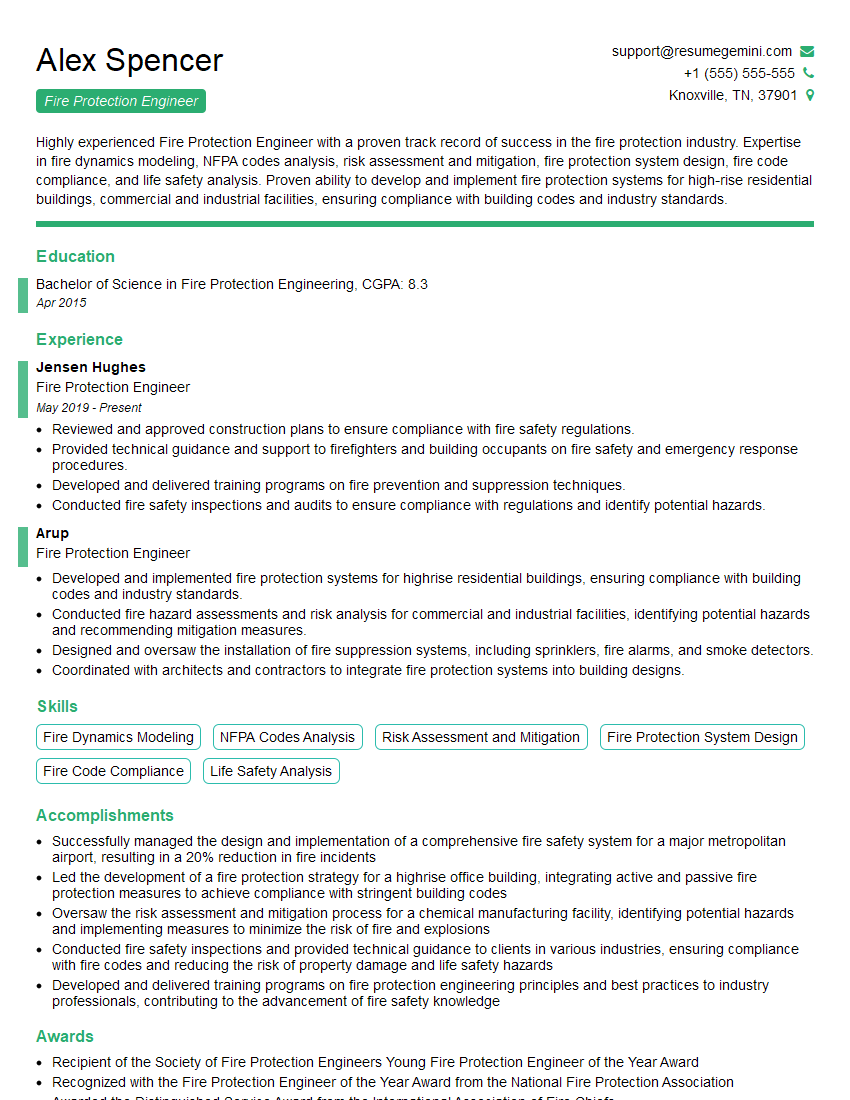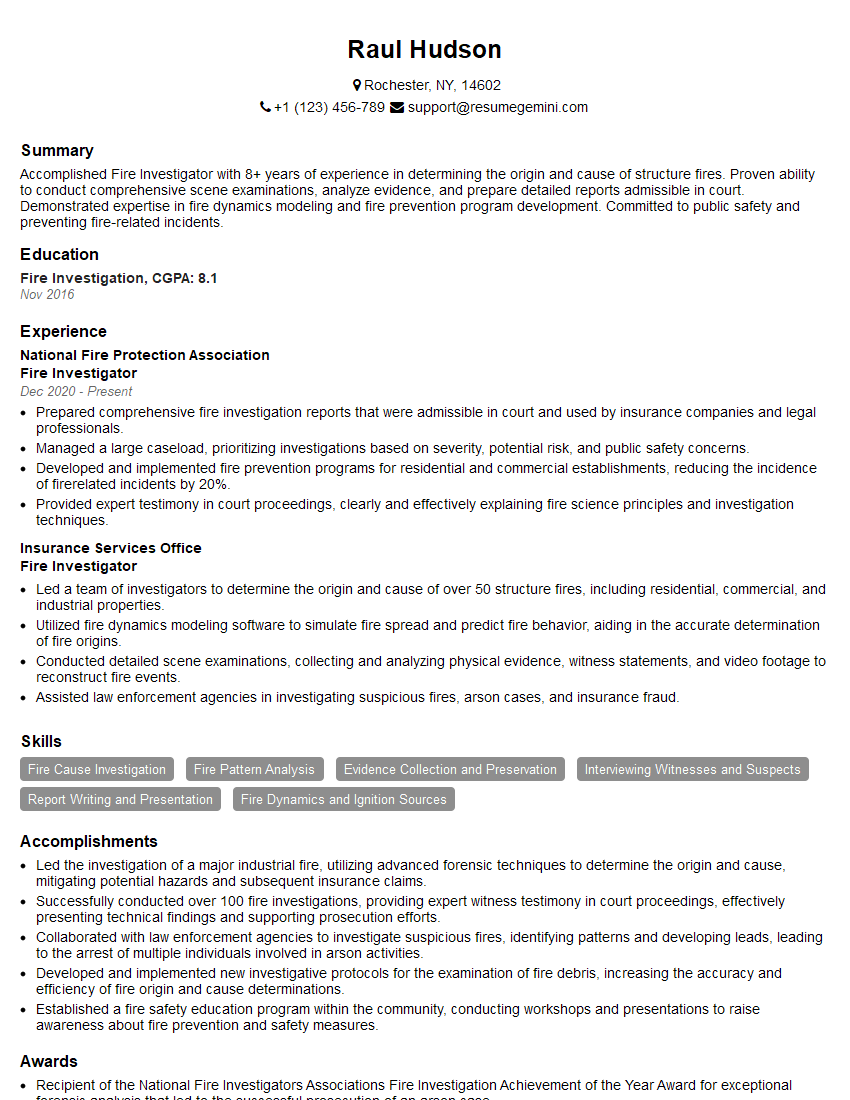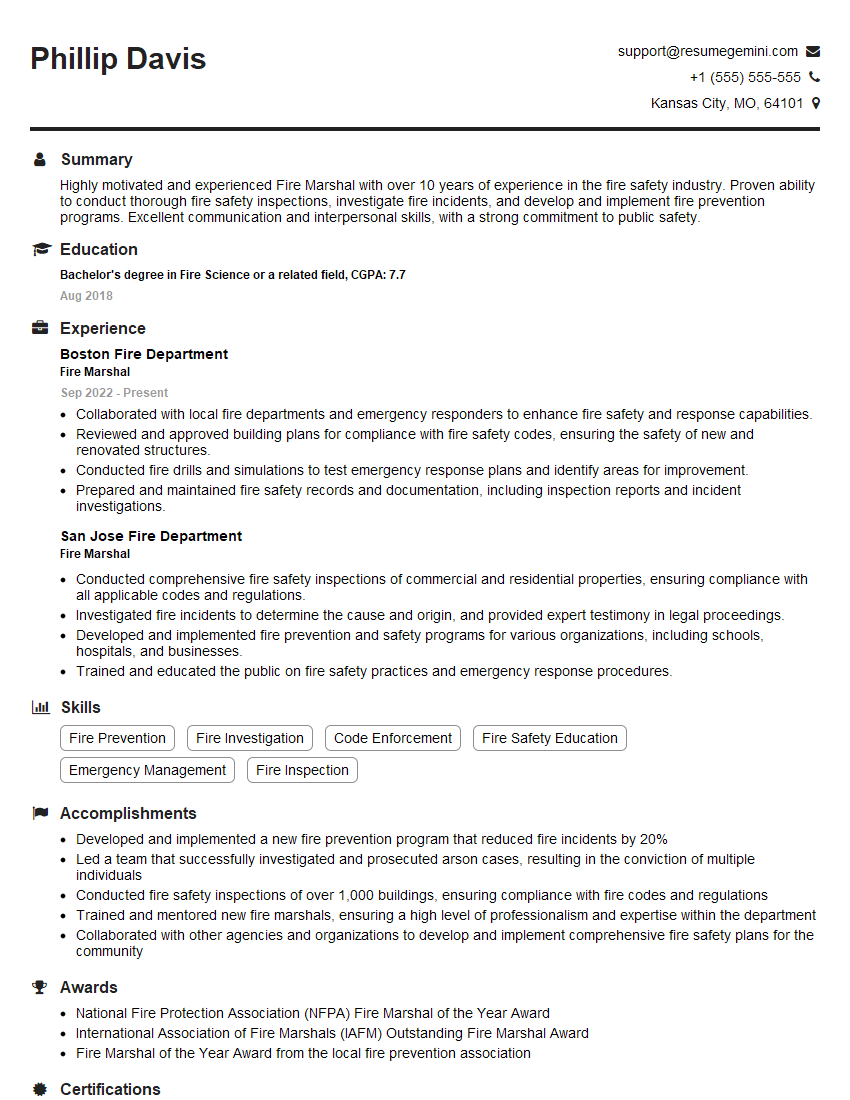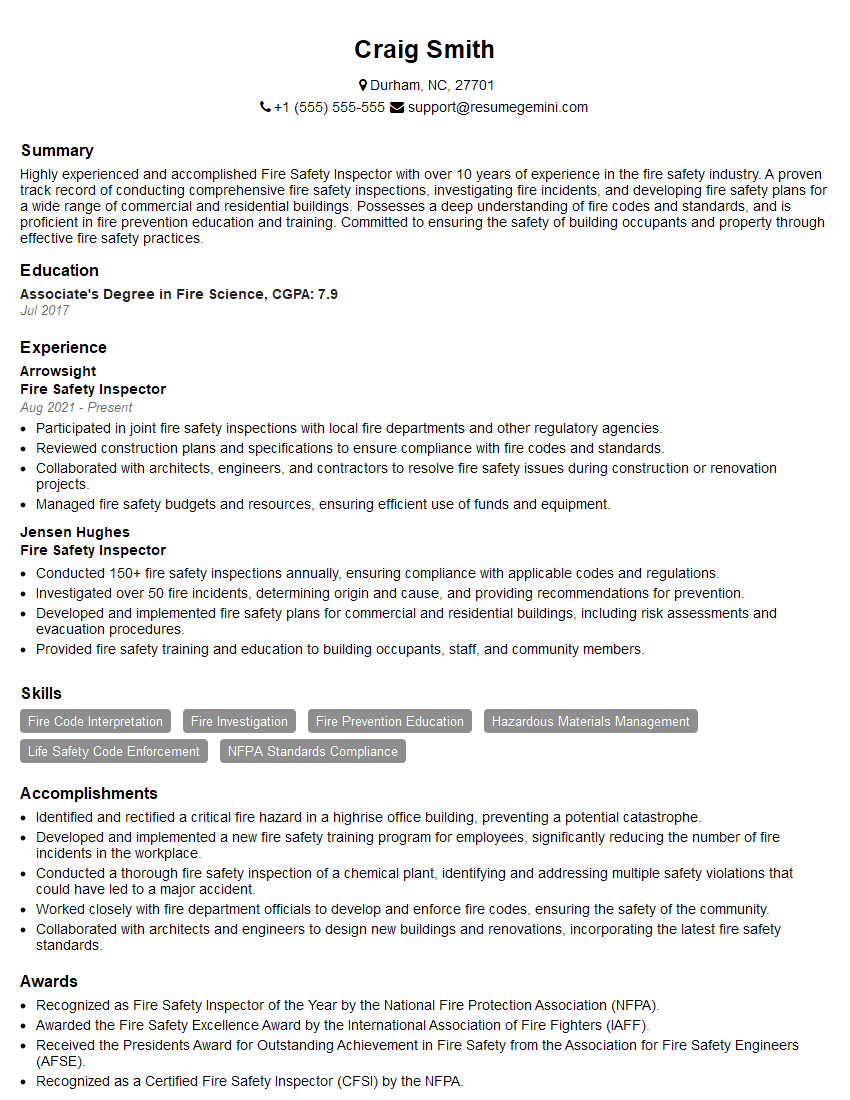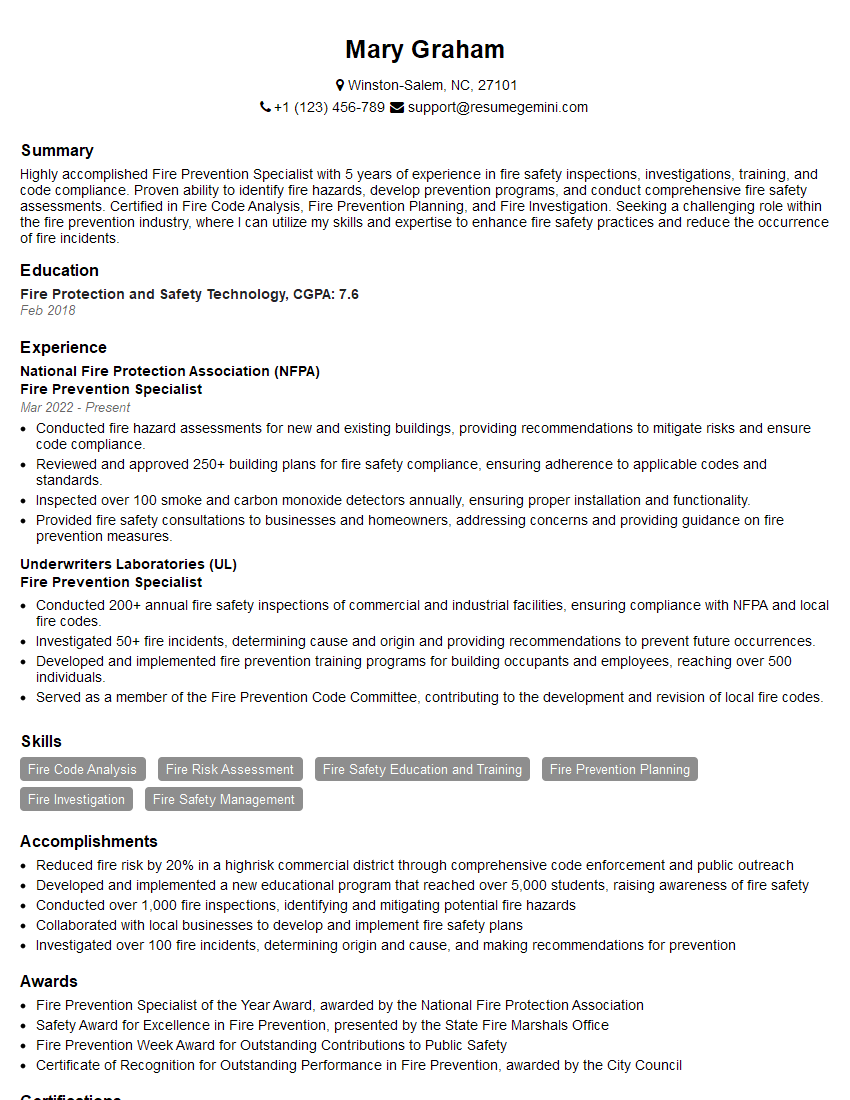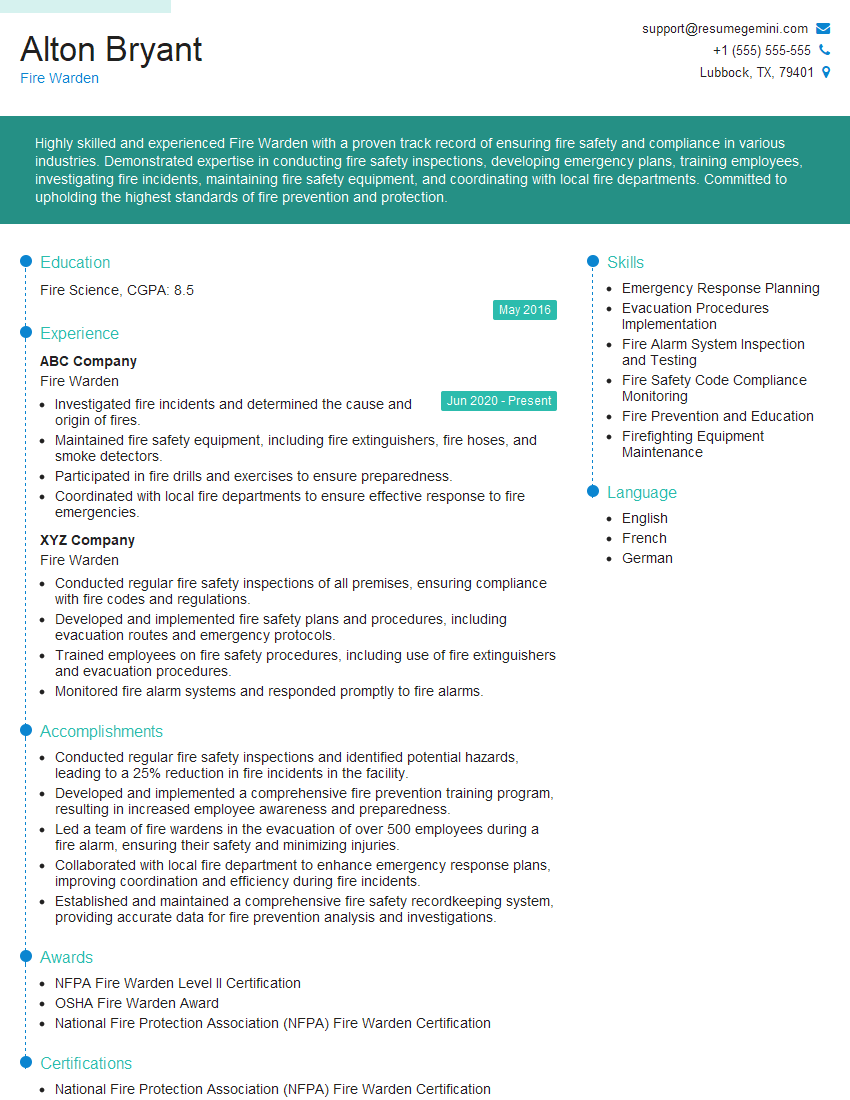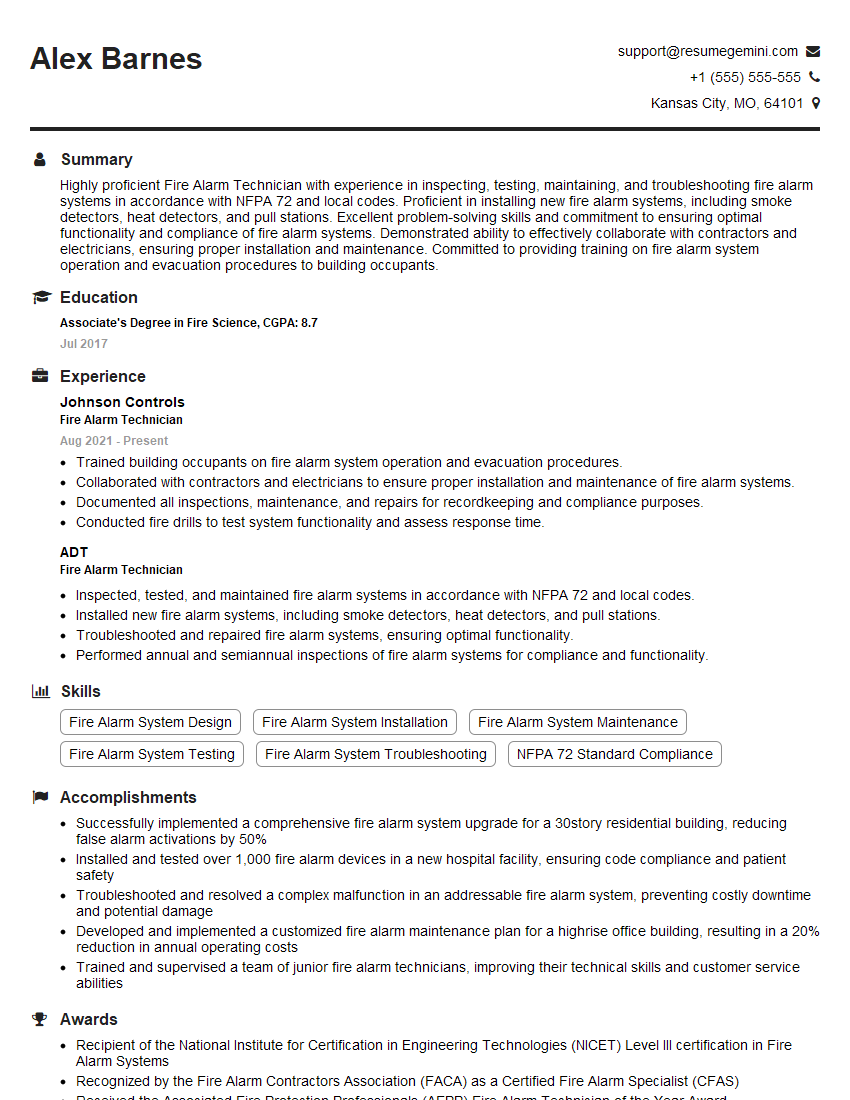Interviews are more than just a Q&A session—they’re a chance to prove your worth. This blog dives into essential Knowledge of fire safety regulations interview questions and expert tips to help you align your answers with what hiring managers are looking for. Start preparing to shine!
Questions Asked in Knowledge of fire safety regulations Interview
Q 1. What are the key components of a fire safety plan?
A comprehensive fire safety plan is the cornerstone of any building’s safety strategy. It’s not just a document; it’s a living, breathing system that dictates how to prevent, detect, and respond to fire incidents. Key components include:
- Fire Risk Assessment: A thorough evaluation identifying potential fire hazards and vulnerabilities within the building.
- Emergency Evacuation Plan: Detailed procedures for safely evacuating occupants, including designated escape routes, assembly points, and communication strategies. This often includes floor plans with clear escape route markings.
- Fire Prevention Measures: Strategies to minimize fire risks, such as proper storage of flammable materials, regular maintenance of electrical systems, and employee training on safe practices. For example, this might include regular inspections of kitchen fire suppression systems.
- Fire Detection and Alarm System: A network of smoke detectors, heat detectors, and fire alarms designed to provide early warning of a fire. Regular testing and maintenance are crucial.
- Fire Suppression Systems: Equipment like fire extinguishers, sprinkler systems, and fire suppression systems specific to the building’s hazards (e.g., kitchen hood suppression). These require regular inspections and servicing.
- Emergency Response Procedures: Steps to take when a fire occurs, including who to contact (fire department, building management), how to use fire suppression equipment, and post-fire procedures.
- Training and Drills: Regular fire safety training for all occupants, including fire extinguisher training and evacuation drills to familiarize everyone with the plan. This ensures everyone knows what to do and how to react effectively during an emergency.
- Record Keeping: Maintaining detailed records of inspections, maintenance, training, and any fire incidents. This ensures accountability and helps identify trends or areas needing improvement. For example, this would include maintenance logs for sprinkler systems.
Q 2. Explain the different classes of fire and the appropriate extinguishing agents for each.
Fires are categorized into classes based on the type of fuel involved, which dictates the most effective extinguishing agent. Mismatched agents can be ineffective or even dangerous.
- Class A: Ordinary combustibles (wood, paper, cloth). Extinguished with water, which cools the fuel and reduces its ability to burn.
- Class B: Flammable liquids (gasoline, oil, grease). Extinguished by smothering the fire, preventing oxygen from reaching the fuel. Carbon dioxide (CO2) or dry chemical extinguishers are effective.
- Class C: Energized electrical equipment. Never use water! CO2 or dry chemical extinguishers are suitable, as they are non-conductive.
- Class D: Combustible metals (magnesium, titanium). Require specialized extinguishing agents designed to cool and prevent further oxidation. Water is usually ineffective and can even worsen the situation.
- Class K: Cooking oils and fats. Require specialized extinguishing agents that prevent reignition. Wet chemical extinguishers are designed for this purpose.
Remember, using the wrong extinguishing agent can be dangerous. Always prioritize evacuation and call emergency services first. Attempting to fight a fire only if you are trained and the fire is small and contained.
Q 3. Describe your experience conducting fire risk assessments.
I have extensive experience conducting fire risk assessments across various building types, from small offices to large industrial complexes. My process typically involves:
- Site Survey: A thorough walkthrough of the premises to identify potential fire hazards, including assessing building materials, electrical systems, storage practices, and occupancy levels. This includes checking for things like blocked fire exits or improperly stored flammable liquids.
- Hazard Identification and Analysis: Categorizing identified hazards based on their likelihood and potential severity. This involves considering factors like the type of hazard, the amount of flammable material present, and the proximity to escape routes.
- Risk Evaluation: Determining the overall risk level associated with each identified hazard. This involves a combination of qualitative and quantitative analysis, considering factors such as the probability of ignition and the potential impact of a fire.
- Risk Control Measures: Developing practical strategies to mitigate identified risks. This may include implementing engineering controls (e.g., installing fire suppression systems), administrative controls (e.g., establishing fire safety procedures), or personal protective equipment (PPE).
- Documentation and Reporting: Producing a comprehensive report detailing the findings of the assessment, including identified hazards, risk levels, and recommended control measures. This report serves as a roadmap for improving the building’s fire safety.
I always tailor my approach to the specific needs and characteristics of each building, ensuring a comprehensive and effective assessment. For example, a high-rise building will require a more detailed analysis of evacuation procedures than a small single-story office.
Q 4. What are the legal requirements for fire safety in your jurisdiction?
Fire safety regulations vary by jurisdiction but generally revolve around the following:
- Compliance with building codes: Buildings must adhere to nationally recognized standards for fire safety design and construction, including requirements for fire-resistant materials, escape routes, and fire suppression systems. These codes often mandate specific features, such as sprinkler systems in certain types of buildings.
- Fire safety inspections: Regular inspections are typically mandated by local authorities to ensure ongoing compliance with regulations. These inspections frequently include checks of fire detection systems and emergency exits.
- Fire risk assessments: Many jurisdictions require periodic fire risk assessments to identify and mitigate potential hazards. These assessments usually include detailed reporting and action plans to address deficiencies.
- Fire safety training: Employees and building occupants must receive appropriate fire safety training, covering topics such as evacuation procedures, the use of fire extinguishers, and how to respond in a fire emergency. The frequency of training often depends on the building’s specific needs and risk levels.
- Maintenance of fire safety equipment: Regular maintenance and testing of fire safety equipment, such as fire extinguishers, smoke detectors, and sprinkler systems, are critical and legally required. This ensures the equipment is ready for use in an emergency.
Failure to comply with these regulations can result in significant penalties, including fines and legal action.
Q 5. How do you ensure compliance with fire safety regulations?
Ensuring compliance involves a multifaceted approach. It’s not a one-time event; it’s an ongoing process.
- Regular Inspections: Conducting routine inspections of all fire safety equipment, systems, and procedures to identify any issues early on. This includes checking things like fire extinguisher pressure, sprinkler heads, and the functionality of alarm systems.
- Maintenance and Testing: Scheduling regular maintenance and testing of fire safety equipment, including fire extinguishers, fire alarms, and sprinkler systems. This maintains functionality and helps to prevent malfunctions during an emergency.
- Record Keeping: Maintaining meticulous records of all inspections, maintenance activities, and training sessions. This documentation is crucial for demonstrating compliance and for identifying trends or areas requiring improvement.
- Training and Drills: Providing regular fire safety training for all occupants and conducting regular evacuation drills to ensure everyone knows what to do in case of a fire. This helps individuals to learn evacuation routes and procedures effectively.
- Compliance Audits: Undertaking periodic compliance audits to assess overall fire safety performance against the relevant regulations and standards. This provides an objective evaluation and identification of areas requiring improvement.
- Staying Updated: Keeping abreast of changes in fire safety legislation and best practices. This ensures compliance with the current standards and adopting improved safety measures. Regular review of updated regulations and industry standards is essential.
Proactive compliance not only prevents legal issues but also fosters a safer environment for everyone.
Q 6. What are the different types of fire detection systems and their limitations?
Several types of fire detection systems exist, each with its own strengths and limitations:
- Smoke Detectors: Detect the presence of smoke, either through ionization (detecting charged particles) or photoelectric (detecting light scattering). Ionization detectors are more sensitive to fast-flaming fires, while photoelectric detectors are better at detecting smoldering fires. Limitations include sensitivity to dust and humidity, and potential for false alarms.
- Heat Detectors: Detect an increase in temperature, either fixed-temperature (triggering at a specific temperature) or rate-of-rise (detecting a rapid temperature increase). Less sensitive to early stages of fire than smoke detectors but less prone to false alarms. Limitations include the potential for fires to spread significantly before triggering.
- Flame Detectors: Detect the infrared or ultraviolet radiation emitted by flames. Effective for open flames but may not detect smoldering fires. Limitations include potential for false alarms from other sources of infrared or ultraviolet radiation, such as sunlight.
- Combination Detectors: Combine multiple detection technologies (e.g., smoke and heat) to enhance reliability and reduce limitations of individual detectors. These offer a more robust solution but can still have some limitations dependent on the specific technology combinations.
The choice of system depends on the specific environment and the type of fires most likely to occur. Regular testing and maintenance are vital for all systems to ensure optimal performance.
Q 7. Explain the process of evacuating a building during a fire.
Evacuating a building during a fire requires a calm, organized approach. The process is as follows:
- Activate the Alarm: If a fire is discovered, immediately activate the fire alarm system. This will alert occupants and emergency services.
- Evacuate Calmly: Leave the building promptly and orderly, using designated escape routes. Avoid panic and help others as needed. Follow directions from fire wardens or designated personnel.
- Account for Everyone: Designate individuals to account for occupants and ensure everyone has safely evacuated.
- Proceed to Assembly Point: Gather at the designated assembly point to ensure everyone is accounted for. This should be a safe distance from the building.
- Contact Emergency Services: If you haven’t already, contact emergency services from a safe location.
- Do Not Re-enter: Once you’ve left the building, do not re-enter under any circumstances. The building should be left to the emergency services.
Regular fire drills are essential for practicing evacuation procedures, ensuring everyone understands the routes and the assembly point. Clear signage, well-lit escape routes, and regular maintenance of exit routes are equally critical for a safe evacuation.
Q 8. How do you develop and implement a fire prevention program?
Developing and implementing a comprehensive fire prevention program requires a systematic approach. It begins with a thorough risk assessment, identifying potential fire hazards within the building or facility. This involves considering factors like the type of occupancy, the materials used in construction, the presence of flammable materials, and the electrical systems. Think of it like a doctor’s check-up for your building’s safety.
Once the hazards are identified, we develop a plan to mitigate those risks. This plan should include:
- Engineering controls: These are physical changes to the building, such as installing fire-resistant materials, improving ventilation, and upgrading electrical systems. Imagine installing sprinkler systems – that’s a prime example of an engineering control.
- Administrative controls: These involve policies and procedures, such as regular inspections, staff training on fire safety, and the establishment of clear emergency evacuation plans. Think of regular fire drills – they are crucial administrative controls.
- Personal protective equipment (PPE): Providing employees with appropriate PPE, such as fire-resistant clothing or respirators, where necessary. This is particularly vital in high-risk environments.
The plan then needs to be implemented, with clear responsibilities assigned to individuals or teams. Regular monitoring and review are crucial, ensuring the effectiveness of the program and making adjustments as needed. Finally, detailed documentation, including training records and inspection reports, is vital for compliance and accountability.
Q 9. What are the responsibilities of a fire warden?
A fire warden plays a crucial role in ensuring the safety of occupants during a fire emergency. Their responsibilities include:
- Familiarization with the building: Knowing the building layout, including fire exits, assembly points, and the location of fire suppression equipment. It’s like being a building’s personal guide in case of emergency.
- Evacuation procedures: Assisting in the safe and orderly evacuation of occupants, ensuring no one is left behind. This involves knowing the best routes and assisting those who might need extra help.
- Fire alarm activation: Knowing how to activate the fire alarm system and report the fire to the emergency services. Time is critical in a fire situation.
- Fire fighting (if trained): Depending on their training, they might assist in initial fire suppression efforts, using fire extinguishers, before the fire department arrives.
- Accountability: Taking a headcount after evacuation, ensuring all occupants are accounted for. No one should be left behind.
Essentially, a fire warden is the first line of defense during a fire, ensuring everyone’s safe evacuation and coordinating with emergency responders.
Q 10. Describe your experience with fire safety training and education.
Throughout my career, I’ve been extensively involved in fire safety training and education. I’ve conducted numerous training sessions for a diverse range of audiences, from factory workers to office staff, tailoring the content to their specific needs and roles.
My training covers various aspects of fire safety, including:
- Fire prevention: Identifying and mitigating fire hazards.
- Fire detection and alarm systems: Understanding how these systems work and what to do in case of an alarm.
- Emergency evacuation procedures: Practicing evacuation drills and understanding the assembly points.
- Fire suppression techniques: Proper use of fire extinguishers and other suppression equipment.
- Relevant regulations and codes: Ensuring compliance with all applicable local, state, and national fire safety regulations.
I’ve utilized a variety of methods, including interactive workshops, practical demonstrations, and online modules, ensuring engagement and knowledge retention. I believe in experiential learning – getting hands-on with fire extinguishers, for instance, dramatically improves understanding and confidence. I also incorporate real-life case studies to highlight the importance of fire safety procedures and the consequences of negligence.
Q 11. How do you investigate fire incidents?
Investigating fire incidents requires a methodical and thorough approach. It starts with securing the scene to prevent further damage or injury and protecting evidence. Then, a systematic investigation is conducted, including:
- Witness interviews: Gathering information from anyone who witnessed the fire or was in the vicinity.
- Physical evidence examination: Analyzing the fire’s origin and pattern of spread, looking for indicators such as burn marks, melted materials, and the presence of accelerants. This often involves specialists like fire investigators.
- Review of building plans and records: Checking for compliance with fire safety codes and regulations.
- Examination of electrical systems: Identifying potential electrical faults as a cause of the fire.
- Use of specialized equipment: Employing tools like thermal imaging cameras or gas detectors to assist in the investigation.
The goal is to determine the cause of the fire, the extent of damage, and any contributing factors. The findings are documented in a comprehensive report, which can be crucial for insurance claims, legal proceedings, or implementing preventative measures to avoid future incidents. It’s akin to solving a complex puzzle, piecing together clues to determine what happened.
Q 12. What are the common causes of fire in buildings?
Common causes of fires in buildings are often related to human error or negligence, alongside some inherent risks of building materials and systems. Some of the most prevalent causes include:
- Electrical faults: Overloaded circuits, faulty wiring, and malfunctioning appliances are frequent culprits. Think of an old space heater left on unattended.
- Smoking materials: Carelessly discarded cigarettes or cigars are a leading cause of residential fires. This often involves leaving a lit cigarette near flammable materials.
- Cooking incidents: Unattended cooking is a significant cause of kitchen fires. Leaving a pan unattended on the stove is a recipe for disaster.
- Heating equipment: Malfunctioning or improperly installed heating systems, such as furnaces or space heaters. Regular maintenance is key to avoid such incidents.
- Arson: Deliberately set fires, which can range from vandalism to insurance fraud.
- Flammable materials: Improper storage of flammable liquids or materials can easily lead to ignition. This often involves keeping paint thinner or other flammable liquids near heat sources.
Understanding these common causes is crucial for implementing effective fire prevention strategies. Addressing these risks through education and preventative measures is key to reducing fire incidents significantly.
Q 13. What are the requirements for fire exits and escape routes?
Fire exits and escape routes are critical for ensuring the safe evacuation of occupants during a fire. Regulations regarding them are stringent and vary slightly depending on location and building type, but some common requirements include:
- Sufficient number and size: The number of exits must be sufficient to accommodate the building’s occupancy load, ensuring everyone can evacuate quickly and safely. Exits should be wide enough to allow for smooth, unhindered flow of people.
- Clearly marked and illuminated: Exits must be clearly marked with signage that is visible even in low-light conditions, such as during a power outage. Emergency lighting is crucial.
- Unobstructed access: Escape routes must be kept free from obstructions at all times, guaranteeing easy passage. Storage should never block fire exits.
- Emergency lighting: Adequate emergency lighting is essential to guide people to safety during a power failure. This is a critical safety feature.
- Separate and protected: Escape routes should be separated from one another to prevent the spread of fire or smoke and ensure alternative routes are available.
- Direct access to the outside: Exits must lead directly to a safe exterior area, away from the building and potential hazards.
Regular inspections of fire exits and escape routes are paramount to ensure they remain unobstructed and functional. It is a matter of life and safety.
Q 14. Explain your understanding of fire suppression systems.
Fire suppression systems are designed to detect and extinguish or control fires, minimizing damage and protecting lives. These systems vary in type, each designed for different applications. They can be broadly classified as:
- Sprinkler systems: These automatically discharge water when a fire is detected, effectively suppressing the flames. They’re one of the most effective ways to control fire spread.
- Fire extinguishers: Portable devices used for initial fire suppression. Different types of extinguishers are used for different classes of fires (A, B, C, D, K). Knowing how to use them correctly is crucial.
- Smoke detectors: These detect smoke particles, alerting occupants to a fire and triggering alarm systems. Early detection is key to minimizing losses.
- Fire alarm systems: These integrate smoke detectors, manual call points, and other components to signal a fire, triggering alarms and notifying emergency services.
- Clean agent systems: These use specialized chemical agents to suppress fires without causing water damage. These are often used in sensitive environments like server rooms.
- Foam systems: These are often used to extinguish flammable liquid fires by creating a layer that smothers the flames.
Regular maintenance and testing of fire suppression systems are crucial to ensure their effectiveness in case of a fire. It’s like having a reliable insurance policy for your building’s safety.
Q 15. How do you manage fire safety during construction projects?
Managing fire safety during construction is paramount, as the inherent nature of construction sites – with readily available combustible materials, ongoing welding and other hot work, and often temporary infrastructure – significantly increases fire risk. My approach is proactive and multi-layered.
Pre-construction Planning: This involves a thorough review of the building plans, identifying potential fire hazards, and incorporating fire safety measures into the design. This includes specifying fire-resistant materials, outlining escape routes, and planning for fire suppression systems.
Site-Specific Fire Safety Plan: A detailed plan is crucial, outlining roles and responsibilities, emergency procedures, and the location of fire safety equipment. Regular training sessions for all workers on the plan and the proper use of fire extinguishers are essential.
Hot Work Permits: All hot work, such as welding or cutting, requires a formal permit system. This ensures proper precautions are taken, including fire watch personnel, the use of fire-retardant blankets, and the availability of fire suppression equipment.
Regular Inspections: Frequent inspections of the site are vital to identify and address potential hazards promptly. This includes checking for proper storage of flammable materials, ensuring clear escape routes, and verifying the functionality of fire safety equipment.
Waste Management: Proper disposal of waste materials, particularly combustible materials, is crucial. Designated storage areas, regular cleanup, and adherence to local waste disposal regulations are essential.
Emergency Response Drills: Regular fire drills ensure that everyone on site is familiar with the emergency procedures and can react effectively in a real fire situation. This builds muscle memory and reduces panic during a real emergency.
For example, on a recent high-rise construction project, we implemented a strict hot work permit system, resulting in zero fire-related incidents throughout the construction phase.
Career Expert Tips:
- Ace those interviews! Prepare effectively by reviewing the Top 50 Most Common Interview Questions on ResumeGemini.
- Navigate your job search with confidence! Explore a wide range of Career Tips on ResumeGemini. Learn about common challenges and recommendations to overcome them.
- Craft the perfect resume! Master the Art of Resume Writing with ResumeGemini’s guide. Showcase your unique qualifications and achievements effectively.
- Don’t miss out on holiday savings! Build your dream resume with ResumeGemini’s ATS optimized templates.
Q 16. Describe your experience working with fire safety codes and standards.
I have extensive experience working with various fire safety codes and standards, including the International Fire Code (IFC), NFPA standards (e.g., NFPA 101 – Life Safety Code), and local building codes. My experience encompasses interpreting these codes, ensuring compliance on diverse projects, and advising on best practices. I’m proficient in identifying code-related risks and recommending appropriate mitigation measures.
For instance, in a recent project involving the renovation of a historic building, I worked closely with the design team and local authorities to balance the preservation of historical elements with the requirements of the updated fire safety codes. This involved proposing innovative solutions that met both heritage preservation and modern safety standards.
Q 17. What are the key elements of a fire safety audit?
A comprehensive fire safety audit is a systematic evaluation of a building or facility’s fire safety measures to identify weaknesses and recommend improvements. Key elements include:
Building Assessment: This involves a detailed examination of the building’s construction, layout, occupancy type, and fire protection systems.
Review of Fire Safety Plans: Analyzing existing fire safety plans, emergency procedures, and employee training programs to ensure their adequacy and effectiveness.
Inspection of Fire Protection Systems: This includes testing and inspecting fire alarms, sprinklers, fire extinguishers, and other fire suppression equipment to confirm functionality and compliance with regulations.
Emergency Exit Assessment: Examining escape routes, signage, and emergency lighting to ensure safe and clear evacuation paths.
Review of Fire Safety Documentation: Checking for appropriate permits, inspection reports, and maintenance records to ensure compliance and ongoing safety.
Identification of Hazards: Pinpointing potential fire hazards, such as storage of flammable materials, electrical hazards, and improper use of equipment.
Recommendations for Improvement: Providing a detailed report with specific recommendations for addressing identified deficiencies and enhancing the overall fire safety of the building.
For example, during a recent audit of a large office building, we identified a critical deficiency in the fire alarm system’s notification capabilities. Our report highlighted the need for system upgrades, ultimately preventing potential loss of life and property.
Q 18. How do you ensure the effectiveness of fire safety equipment?
Ensuring the effectiveness of fire safety equipment is crucial. My approach is based on a three-pronged strategy:
Regular Inspections and Testing: This involves conducting routine visual inspections and functional tests of all equipment, according to manufacturer’s instructions and relevant codes. This includes checking fire extinguishers’ pressure, sprinkler system pressure, and the functionality of fire alarms.
Preventative Maintenance: A preventative maintenance schedule is critical. This involves regular servicing of fire suppression systems, replacing outdated components, and ensuring the overall upkeep of all fire safety equipment. This includes regular servicing of fire extinguishers and sprinkler heads.
Record Keeping: Maintaining detailed records of all inspections, tests, and maintenance activities is essential. This documentation provides a verifiable audit trail, demonstrates compliance, and aids in proactive management of the fire safety systems.
For example, on a recent project involving a manufacturing facility, we implemented a comprehensive preventative maintenance program that significantly reduced equipment malfunctions and ensured the continuous readiness of the fire safety systems.
Q 19. What is your experience with emergency response procedures?
My experience with emergency response procedures is extensive. I’ve developed and implemented emergency plans for various facilities, conducted numerous training sessions, and participated in emergency response drills. I understand the importance of clear communication, efficient evacuation procedures, and coordination with emergency services.
For example, I led the development of an emergency response plan for a large hospital. This plan detailed procedures for evacuating patients, staff, and visitors, coordinating with local fire and rescue services, and managing potential casualties. The plan included detailed floor plans, designated assembly points, and communication protocols.
Q 20. How do you communicate fire safety information to employees?
Communicating fire safety information effectively is crucial. My approach involves a multi-faceted strategy:
Training Programs: Tailored training sessions, using a mix of presentations, demonstrations, and hands-on exercises are crucial. The training is adapted to the specific needs and roles of the employees.
Regular Drills: Regular fire drills simulate real-life scenarios, reinforcing training and ensuring familiarity with evacuation procedures.
Signage and Posters: Clear and concise signage, strategically placed throughout the facility, provides visual reminders of fire safety procedures and the locations of fire safety equipment.
Written Materials: Providing employees with written guides, including clear instructions and emergency contact information.
Interactive Sessions: Using interactive elements like quizzes, and Q&A sessions to ensure employees fully understand and retain the information.
For instance, in a manufacturing facility, we implemented a gamified fire safety training program, which resulted in a significant improvement in employee knowledge and engagement.
Q 21. What are the challenges in maintaining fire safety in a large building?
Maintaining fire safety in a large building presents unique challenges. These include:
Complexity of Systems: Large buildings often have complex fire protection systems that require ongoing maintenance and monitoring.
Occupancy Variations: Different areas within the building may have varying occupancy types and associated fire risks, necessitating tailored safety measures.
Staff Coordination: Coordinating fire safety efforts across a large and diverse workforce requires clear communication, training, and management.
Accessibility: Ensuring that all areas of the building are accessible for inspections and maintenance of fire protection systems can be challenging.
Cost Considerations: Maintaining a high level of fire safety in a large building can be expensive. Balancing cost-effectiveness with the necessary safety measures requires careful planning.
Addressing these challenges requires a proactive, well-resourced approach, including a dedicated fire safety team, a comprehensive maintenance program, and a robust emergency response plan. For example, a phased approach to upgrading fire safety systems in a large hospital minimizes disruption while ensuring continuous safety.
Q 22. Explain the importance of regular fire drills and inspections.
Regular fire drills and inspections are crucial for ensuring a building’s fire safety preparedness. They’re not just about compliance; they’re about saving lives and minimizing property damage. Drills familiarize occupants with evacuation procedures, identify weaknesses in the plan, and build muscle memory for reacting effectively under pressure. Inspections, on the other hand, proactively identify potential fire hazards before they can ignite, from faulty wiring to improperly stored materials.
- Drills: Think of a fire drill like a dress rehearsal for a play. You wouldn’t put on a show without rehearsing, right? Regular drills ensure everyone knows the escape routes, assembly points, and their roles during an evacuation. They also highlight any confusion or bottlenecks in the process, allowing for improvement.
- Inspections: Imagine a mechanic regularly inspecting your car. They identify potential problems before they become major issues, saving you time and money. Similarly, fire inspections find potential hazards – blocked exits, malfunctioning fire extinguishers, or flammable materials stored incorrectly – preventing incidents before they occur.
For example, during a recent drill at a large office complex, we discovered that a newly installed partition partially blocked a crucial exit route. This was immediately rectified, preventing a potentially disastrous situation during a real emergency.
Q 23. How do you handle fire safety emergencies effectively?
Handling fire safety emergencies effectively hinges on a well-defined plan, swift action, and clear communication. My approach follows a structured methodology:
- Activate the alarm: Immediately initiate the building’s fire alarm system to alert occupants and emergency services.
- Evacuate the premises: Follow established evacuation procedures, ensuring all personnel are accounted for. This involves checking rooms and assisting those who may need help.
- Contact emergency services: Provide clear and concise information to emergency responders – location, nature of the fire, potential hazards, and number of occupants.
- Secure the area: If possible and safe, take steps to contain the fire, such as using fire extinguishers, but only if trained and comfortable doing so. Prioritizing personal safety is paramount.
- Account for everyone: Once safely outside, conduct a headcount to ensure everyone has evacuated. This confirms the safety of personnel and helps with directing emergency response efforts.
- Post-incident procedures: This includes cooperating with fire investigators, documenting the incident, and reviewing procedures to prevent future incidents.
For example, I was involved in a situation where a small kitchen fire erupted. By following these steps, the fire was contained quickly, preventing significant damage. Proper evacuation protocols and swift action by staff minimized risk to occupants.
Q 24. How do you stay updated on changes in fire safety regulations?
Staying updated on ever-changing fire safety regulations demands a proactive and multi-faceted approach. I utilize several strategies to remain informed:
- Subscription to professional journals and publications: NFPA (National Fire Protection Association) journals and similar publications keep me abreast of the latest research and advancements.
- Attendance at industry conferences and workshops: These events offer valuable insights into best practices and regulatory changes directly from experts and regulatory bodies.
- Networking with other professionals: Regular interaction with colleagues and experts in the field facilitates knowledge sharing and updates on new regulations.
- Monitoring government websites and regulatory bodies: I actively monitor official websites for updates, changes in codes, and compliance guidelines.
- Continuing education courses: Formal training courses and certifications ensure compliance and enhance my understanding of current standards.
For instance, recent changes in occupancy load calculations required me to update our building’s evacuation plans and emergency procedures to maintain compliance.
Q 25. What is your experience with fire alarm systems maintenance?
My experience with fire alarm system maintenance encompasses both preventive and corrective measures. Preventive maintenance is crucial; it avoids costly repairs and downtime.
- Regular testing: Weekly and monthly testing of alarm systems (including manual pull stations, smoke detectors, heat detectors) ensures functionality and early detection of potential issues.
- Annual inspections: Yearly thorough inspections by certified technicians identify any components needing repair or replacement. This includes checking wiring, batteries, and the central control panel.
- Documentation: Meticulous record-keeping of all maintenance activities, including dates, findings, and corrective actions taken, is critical for compliance audits.
- Corrective maintenance: Addressing any identified issues promptly, including replacing faulty components or addressing wiring problems. This prevents escalating problems and ensures reliable system operation.
In a recent project, we discovered a faulty connection in the alarm system’s main power supply during a routine inspection. Addressing it prevented a potential system failure and ensured the safety of occupants.
Q 26. Explain your understanding of Passive Fire Protection systems.
Passive fire protection systems are crucial safety measures that limit the spread of fire and smoke without any active intervention. They are designed to create fire barriers and delay the advancement of flames, giving occupants valuable time to evacuate.
- Fire-resistant materials: Materials with high fire resistance ratings, like concrete, steel, and specialized drywall, are used in building construction to contain fire spread.
- Fire-rated doors and walls: These act as barriers to prevent fire’s movement between compartments. Their fire resistance rating (e.g., 1-hour, 2-hour rated) indicates how long they can withstand fire exposure before failure.
- Firestopping: This involves sealing penetrations in fire-rated walls and floors (e.g., for pipes, cables) to maintain their fire resistance. Incorrect firestopping can seriously compromise the integrity of the system.
- Smoke dampers: These automatically close in the event of a fire, preventing smoke spread through ductwork.
Think of them as the building’s ‘passive defense system’. They work silently in the background, offering crucial protection without requiring any active action during a fire. Their correct installation and maintenance are paramount for effective fire safety.
Q 27. Describe your approach to identifying and mitigating fire hazards.
Identifying and mitigating fire hazards demands a systematic and comprehensive approach. My strategy involves:
- Regular inspections: Conducting routine inspections to identify potential hazards, including blocked exits, overloaded electrical circuits, improperly stored flammable materials, and malfunctioning equipment.
- Hazard analysis: A thorough evaluation of the building’s layout, occupancy, and processes to identify potential fire risks and vulnerabilities.
- Risk assessment: Prioritizing identified hazards based on their potential severity and likelihood of occurrence. This involves considering factors like proximity to ignition sources and the presence of flammable materials.
- Mitigation strategies: Implementing appropriate control measures, including removal of hazards, improved housekeeping, installation of fire suppression systems, and employee training.
- Documentation: Maintaining detailed records of inspections, hazard assessments, and implemented mitigation measures.
For example, during an inspection, I noticed improperly stored chemicals in a laboratory. This was immediately addressed by relocating the chemicals to a designated storage area and training personnel on proper chemical handling.
Q 28. How do you manage and document fire safety incidents?
Managing and documenting fire safety incidents requires a systematic and thorough approach to ensure accountability, prevent future occurrences, and meet regulatory requirements.
- Immediate response: Swift action during the incident, as described earlier, ensures safety and limits damage.
- Incident report: A detailed report capturing the date, time, location, cause, extent of damage, injuries sustained, and actions taken. This report should follow a standardized format.
- Investigation: A thorough investigation to determine the root cause of the incident, encompassing witness interviews, examination of physical evidence, and review of security footage.
- Corrective actions: Implementing measures to prevent similar incidents from recurring, including improvements in procedures, training, equipment upgrades, and infrastructure modifications.
- Documentation and record-keeping: Maintaining a comprehensive log of the incident, including the investigation findings, corrective actions, and follow-up measures. This is essential for both internal review and external audits.
In a previous incident involving a small electrical fire, our detailed documentation, including witness statements and photographs, enabled us to trace the problem to faulty wiring and implement a comprehensive rewiring project. This prevented future incidents of this nature.
Key Topics to Learn for Knowledge of Fire Safety Regulations Interview
- Fire Prevention Strategies: Understanding proactive measures like risk assessments, fire prevention plans, and the importance of regular inspections and maintenance of fire safety systems.
- Fire Detection and Alarm Systems: Familiarize yourself with various types of detectors (smoke, heat, flame), alarm systems (manual pull stations, automatic systems), and their proper installation and testing procedures. Understand the practical application of these systems in different building types.
- Emergency Response Procedures: Master evacuation plans, procedures for summoning emergency services, and the role of fire wardens. Consider practical applications, such as leading an evacuation drill or handling a minor fire incident.
- Fire Suppression Techniques: Learn about various fire suppression methods (e.g., water, foam, dry chemical extinguishers) and their appropriate applications based on fire class. Understand the limitations and safety precautions associated with each method.
- Fire Safety Regulations and Codes: Gain a working knowledge of relevant national or local fire codes and regulations. This includes understanding building codes related to fire safety and egress planning.
- Fire Safety Training and Education: Understand the importance of employee training programs and their role in fostering a safety-conscious environment. Think about how you would design and implement a comprehensive fire safety training program.
- Risk Assessment and Mitigation: Explore methods for conducting fire risk assessments, identifying potential hazards, and implementing control measures to mitigate risks. Understand how to prioritize these measures based on the level of risk.
Next Steps
Mastering knowledge of fire safety regulations is crucial for career advancement in many sectors, demonstrating your commitment to safety and your ability to contribute to a secure work environment. A well-crafted resume is your key to unlocking these opportunities. An ATS-friendly resume, optimized for applicant tracking systems, significantly increases your chances of getting noticed by recruiters. ResumeGemini is a trusted resource that can help you build a professional and impactful resume. Examples of resumes tailored to showcase expertise in fire safety regulations are available to guide you. Take the next step towards a successful career; build a strong resume with ResumeGemini today.
Explore more articles
Users Rating of Our Blogs
Share Your Experience
We value your feedback! Please rate our content and share your thoughts (optional).
What Readers Say About Our Blog
Live Rent Free!
https://bit.ly/LiveRentFREE
Interesting Article, I liked the depth of knowledge you’ve shared.
Helpful, thanks for sharing.
Hi, I represent a social media marketing agency and liked your blog
Hi, I represent an SEO company that specialises in getting you AI citations and higher rankings on Google. I’d like to offer you a 100% free SEO audit for your website. Would you be interested?
